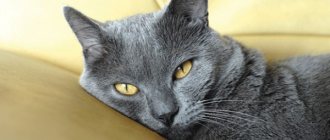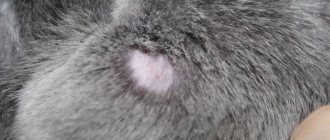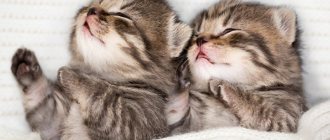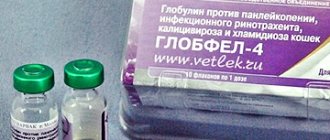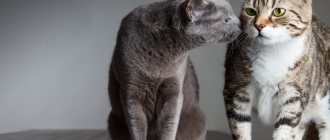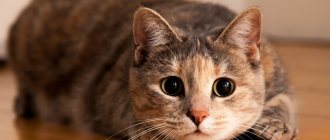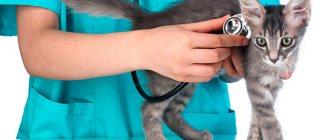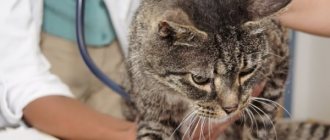Pathologies in which a cat falls on its side when walking
This symptom may include epilepsy, stroke, development of paralysis or paresis, muscle dystrophy or ataxia.
A cat with epilepsy falls on its side.
Depending on the nature of the pathology, the onset of symptoms can occur either slowly or rapidly.
.
In both cases, contacting a veterinarian is mandatory
. In addition to obvious signs, there may be a shaky, uncertain gait, fear of movement, and the animal cannot lean on one of its sides or limbs.
Paralysis or paresis
The development of paralysis or paresis can occur, inflammatory processes, and disturbances in the blood flow of the body.
But it can also be explained by injuries to the back and spine. With this disease, parallel symptoms are observed: fainting, “shifty” eyes - nystagmus, inappropriate behavior, pupils of different sizes.
With paralysis, fainting occurs.
If the lumbar or pelvic area is affected
, there may be a violation of the act of defecation and urination. Similar symptoms will occur with spinal cord oncology or with nutritional hyperparathyroidism.
Muscle weakness
Muscle weakness in a cat is accompanied by lethargy.
Muscle weakness is provoked by myopathy based on potassium deficiency in the body, infectious diseases, viruses, in particular botulism.
Parallel symptoms of internal bleeding may include cold extremities
, lethargy, refusal of food and water, constant drowsiness, bluish mucous membranes.
Ataxia
The presence of ataxia is characterized by periodic rolling over on one side.
Ataxia can be congenital or acquired depending on its occurrence factors.
They differ in appearance into vestibular, cortical, cerebellar, and sensitive forms.
. The presence of ataxia is characterized by an unsteady gait and periodic lying on one side.
- The animal walks very unsteadily, stepping on its paws with caution.
- The head is tilted down or to the side, muscle tremors are possible.
- The following are often involved in the development of pathology: various poisonings, traumatic brain injuries, cerebral edema.
- At the same time, cerebellar ataxia is most common in small kittens and occurs due to hypoplasia of the cerebellar structure.
Epileptic seizure
An epileptic seizure is manifested not only by falling on one side, but also by the onset of convulsions, twitching of the paws, involuntary closing of the jaws or uncontrolled urination.
During an epileptic seizure, convulsions occur in the cat.
Stroke
The stroke is accompanied by a loud cry in the cat.
During a stroke, the animal experiences circular movements and loud meowing due to severe pain. And also fainting.
Otitis
With otitis media, a cat has ear pain.
A possible reason for the appearance of this symptom may be otitis media, leading to a disorder in the functioning of the vestibular apparatus. Additional symptoms are loss of appetite, foul odor from the ear, discharge of purulent exudate, pain in the ear area.
Physiotherapy for cats with leg paralysis
The recovery period after paralysis drags on for a long time; in this case, the animal owner cannot do without physiotherapy.
Veterinarians advise performing a daily set of exercises to help restore neurological functions.
- Passive movements. Place the cat on its back and move the paralyzed legs alternately in a circular motion for at least five minutes. The exercise is similar to riding a bicycle.
- Stimulating massage. Stretch your paw pads and limbs daily.
- Scratching. Scratch the paralyzed animal in different places; even with little progress, the cat will try to scratch with its hind paw.
- Using an inflatable ball. Place the cat on its stomach on the ball, so that its paws lightly touch the floor. Roll the ball while holding your pet back and forth.
- Using support. Pass a wide strip of fabric under your pet's belly and try to walk with the animal, holding the ends of the fabric.
- Moving limbs. Take the cat by the hind legs and slowly move them, imitating walking.
- Swimming. Make the cat swim in the bath every day, holding the animal so that it does not choke.
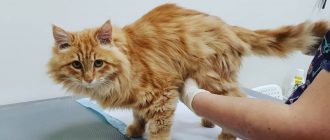
Video about a cat with ataxia
The nervous system is the most important for the body, as it controls absolutely all processes occurring in it. With its lesions, a wide variety of effects can be observed, often combined with the term ataxia. This pathology may well occur in cats.
Without going into details, this is the name for a set of symptoms that imply problems with coordination of movements and body position in space. There are three types of this pathology:
- Cerebellar
ataxia in cats is caused by damage to the cerebellum.
- Accordingly, vestibular
occurs in cases where something is very wrong with the vestibular apparatus located in the inner ear.
- Sensitive
. In some ways it is similar to the cerebellar, only in this case important nerve cords are damaged.
There are different causes of ataxia in cats. Most often, the development of the disease is due to:
- Poisoning with various poisons.
- Hereditary diseases accompanied by degenerative phenomena in the nervous tissue.
- Injuries that occur especially often in March, when loving cats fall from balconies.
- Lack of vitamin B1. This is generally typical for cats: many owners “pamper” them with fresh river fish, which contains the enzyme thiaminase. It destroys thiamine, that is, B1, resulting in ataxia. This is especially noticeable in kittens.
- If the cat is “hooked” on some plants. For example, a large dose of catnip can send a cat into “nirvana” for several minutes. At this time, the pet looks like an inveterate drunkard.
- Traumatic brain injury.
- Tumor.
- Infection. In particular, the feline is very dangerous.
- or cerebral edema.
Why are the hind legs lost?
There are many reasons why a cat loses its hind legs: problems with the musculoskeletal system, a broken blood clot, lack of vitamins and minerals, encephalitis, tumor, joint diseases, stroke. The consequences of pathology directly depend on the root cause and the promptness of taking medical measures.
Spinal injuries
Associated symptoms depend on the type and severity of the injury, its location, and the presence of other injuries. The cat may experience pain when touched, trying to stand up or change body position, urinary and fecal incontinence; Often the animal's paws become cold. With traumatic injury to the spine, spinal shock may occur - a condition characterized by rapid breathing and heartbeat, decreased body temperature, and fainting.
Sometimes the effects of an injury appear only after several weeks or even months. With timely treatment and the absence of serious complications, restoration of sensitivity and mobility is possible. If damage is detected, the cat must be placed on a hard, flat surface and immediately taken to a doctor.
Herniated disc in an animal
The transmission of impulses to the hind limbs is impaired due to compression of the nerve endings of the spinal cord as a result of a herniated disc. These cartilaginous formations, connecting the vertebrae to each other, ensure their mobility and shock absorption. If the outer shell of the discs becomes thinner, the internal contents leak out and pinch the nerve endings of the spinal cord.
Spinal cord inflammation
The cause of paralysis of the hind limbs in a cat can be an inflammatory process in the spinal cord, which is caused by infections (viral, bacterial, parasitic), autoimmune diseases, poisoning, and in pregnant cats - purulent inflammation. The pathology is accompanied by weakness, pain, urinary incontinence, fever, and impaired intestinal motility.
Arterial thromboembolism in a cat
Arterial thromboembolism is a condition when the lumen of a vessel is completely or partially closed by a thrombus. It is not an independent disease; it is caused by diseases that lead to the formation of blood clots - pathologies of the cardiovascular, pulmonary, circulatory systems, atherosclerosis.
The blood flow is disrupted, organs and tissues do not receive enough oxygen, and metabolic products accumulate in them. With thromboembolism of the lower extremities, swelling and sharp pain occur, coordination of movements is impaired, the pads of the paws turn pale, and the pet begins to limp and drag its legs. At the same time, the cat has cold paws. If blood supply is not restored within a few hours, tissue necrosis will begin.
Vitamin deficiency in an animal
Vitamin deficiency develops as a result of prolonged lack of vitamins. It leads to serious physiological disorders. Typically occurs in nursing cats and young animals. The pathology is caused by dietary errors, long-term antibiotic therapy, infectious and parasitic diseases. Weakness and failure of the limbs are usually observed with a lack of vitamin B1. Vitamin deficiency is indicated by lethargy, apathy, decreased urine production, and elevated temperature. Due to loss of appetite, your pet may lose noticeable weight.
Hip dysplasia
Dysplasia is an anomaly in which, due to disruption and development of connective tissue, the joints become pathologically mobile. In cats, it occurs infrequently and more often affects purebred individuals - Maine Coons, Norwegian forest cats, British, Scottish, Persians, Siamese, Abyssinians, exotics. Signs of the disease usually begin to appear in the first 6 months of a kitten's life.
The causes of the pathology include hereditary predisposition, obesity, hormonal imbalances, injury, and calcium deficiency. With hip dysplasia, the pet avoids stepping on the affected paw, limps, has difficulty standing up, walks unsteadily and unsteadily. When it moves, you can hear a crunching sound. The cat lies with its limbs stretched out to the sides, and does not tuck them under its stomach, as usual.
Nutritional hyperparathyroidism
The disease is caused by an excess of parathyroid hormone, which is responsible for calcium-phosphorus metabolism. As a result, calcium is removed from the bone tissue and enters the blood. Depletion and destruction of bones occurs, deformations and curvatures are observed. The animal experiences pain in its paws and begins to limp. Hind limbs can also be lost due to neurological disorders caused by vertebral injuries.
Nutritional hyperparathyroidism is caused by a malfunction of the parathyroid glands. It is caused by an imbalance of minerals due to errors in nutrition, when it contains too little calcium, magnesium, vitamin D. This can occur with prolonged feeding of one type of natural food.
Tick bites
An encephalitis tick bite can cause paralysis of the limbs. The symptom does not appear immediately, but only after a few days. The first signs of tick-borne encephalitis are weakness, fever, poor appetite, and discharge of serous fluid from the eyes and nose. Sometimes your pet feels nauseous and may begin to burp frequently. When the infection reaches the brain and central nervous system, fainting, convulsions, and paralysis occur. The death of the animal occurs in 50% of cases, the outcome depends on the timeliness of taking measures.
Symptoms and diagnosis
In general, the symptoms of ataxia in cats are simple. The pet looks like a drunkard, he shakes, the cat cannot walk normally, in severe cases he falls on his side with a roar, just trying to sit down. A constant tilt of the head to one side, as well as erratic circular eye movements, are very typical. Other symptoms may vary depending on the underlying cause of the ataxia. For example, a cat “under mint” can walk with a wobbling gait with its head held high; from time to time, it shakes it and generously splashes saliva around. It looks terrible, but goes away quickly.
Your veterinarian will perform a complete physical examination of your cat. The information provided by the cat's owner is important. It is advisable to remember the following:
- Did the animal have access to household chemicals, poisons, or was deratization (rodent extermination) carried out in your home or area?
- Is there any information in your pet’s pedigree about any pathologies that the cat’s parents suffered from?
- Did the cat fall from the balcony, did it get hit by a bicycle, etc.
Symptoms of pathology
Most often, limb paralysis does not occur immediately. First, signs of motor dysfunction appear, which is why the pet does not immediately lose control of its legs, but gradually. Veterinarians recommend not to hesitate to contact the clinic
if the following symptoms appear:
- The cat begins to hesitantly step on the pads. Before he steps, he tries to find his balance.
- Dragging appears when the cat is unable to move its paws: it drags them without lifting them off the floor. It seems that the pet is sneaking up on the prey during the hunt. The next stage will be paralysis of the lower or lateral part of the body.
- The cat's limbs move greatly when walking or standing.
- Constant back squatting. This often occurs in older individuals over 10 years of age.
- Severe swelling in the pelvic cavity due to bites from dogs or other cats, trauma, problems with internal organs or the lower part of the spine.
- General loss of mobility even in a young animal. The cat prefers the opportunity to lie down and relax to games.
The appearance of one or more symptoms becomes a reason to contact a veterinary hospital. Delay in consultation may result in paralysis of part of the body.

The only non-dangerous situation is a wobbling gait in small kittens. This is a natural reason, it is explained by the weakness of muscle tissue at a young age. This goes away over time and does not require therapy.
This is interesting: Sores on the skin of a cat
Treatment Basics
Be that as it may, the treatment of ataxia in cats depends purely on the reasons that caused pathological changes in the animal’s behavior. In case of poisoning
It is important to determine what exactly the animal was poisoned with. In all cases, activated carbon is prescribed, which partially absorbs the toxin, and intravenous administration of supporting compounds is practiced.
If the reasons for a cat’s somewhat inappropriate behavior lie in a “dose” of catnip or valerian
, there is no need to worry: within a few minutes the effect of the substances will end and the animal will become normal again.
For traumatic brain injuries
or even suspicions about them, you need to urgently take the cat to the veterinarian. He will assess the condition of the animal. If the brain has been damaged, there is a high probability of death, or the animal turning into a “vegetable”. In this case, euthanasia is recommended. In other cases, emergency surgery can save the cat. Similarly - in cases of back injuries, which may in one way or another threaten the integrity of the spinal cord.
Thiamine deficiency
, which is detected using a biochemical blood test, is eliminated by a balanced diet and the exclusion of foods containing thiaminase from the diet. In severe cases, vitamin B1 injections and oral multivitamin preparations may be necessary.
Amateur cat breeders sometimes encounter unusual and even strange behavior in their pets. For example, a cat walks in circles, refuses to eat, bumps into walls and does not seem to realize what is happening. Complaints about such symptoms appear from time to time on veterinary forums, and every owner should know about the reasons that can cause walking in circles.
Why can a cat walk in circles?
Every owner needs to understand that if a cat starts walking in circles, then this is a fairly serious symptom and should under no circumstances be ignored. The reasons for this behavior may vary. The most harmless of them is worms. In this case, the animal demonstrates restless behavior at night, can take multiple walks along the same route, but its coordination is not impaired and during the day it behaves more calmly. In this case, a regular anthelmintic purchased at a veterinary pharmacy will help.
But it happens that walking in circles is accompanied by other, more serious symptoms, such as
:
- impaired coordination;
- loss of appetite;
- twitching of limbs;
- legs give way;
- tongue hanging out.
All these unpleasant signs indicate that the animal’s nervous system has been damaged. Most often, older animals suffer from such problems, but occasionally symptoms can also be observed in young ones. The cat walks clockwise or counterclockwise, sometimes it can bump into walls, or fall to the floor and kick its feet.
It is possible to identify the main possible causes of such disorders on the part of the central nervous system, these are:
:
- a brain tumor;
- stroke;
- toxoplasmosis;
- otitis;
- high blood pressure.
The latter option most often occurs in cats with kidney failure and can lead to stroke, so cats with chronic kidney disease should undergo periodic veterinary monitoring and receive appropriate treatment.
If kidney problems have been going on for more than a year, such an animal should be treated with increased attention. If the case is advanced, the cat walks in circles and its condition gets worse, the situation can end in tears.
How to help if your cat is walking in circles
In this case, it is more important than ever to correctly and timely determine the cause of the problem and make the correct diagnosis.
Self-medication is unacceptable here. As mentioned above, such symptoms are only rarely evidence of non-serious diseases, such as helminthiasis. In all other cases, if a cat walks in a circle, the pet’s health is in danger, which means that it needs to be taken to a veterinary clinic as soon as possible or a veterinarian can be called to your home. Such symptoms should not be ignored under any circumstances.
It is necessary to describe the cat's condition in detail to the veterinarian, as well as describe the animal's lifestyle, diet, possible injuries or other reasons that could lead to behavioral disorders.
It is especially worth paying attention to such problems as previous otitis media, physical injuries, blows, bruises, falls from great heights and other situations in which the cat could have been injured.
Then, based on the results of the examination, a diagnosis is made and treatment and medication are prescribed for the cat. For tests, you may need to give urine and blood (detailed biochemistry and OKA), do an ultrasound examination, or an MRI. Sometimes the animal is given a drip or given injections.
During this period, the cat’s appetite may be severely impaired, it may refuse to eat, so its body must be helped to remain in a viable state, for this purpose the administration of saline solutions is prescribed.
But we don’t say goodbye to you here, come back again!
Subscribe to our page updates on
Amateur cat breeders sometimes encounter unusual and even strange behavior in their pets. For example, a cat walks in circles, refuses to eat, bumps into walls and does not seem to realize what is happening. Complaints about such symptoms appear from time to time on veterinary forums, and every owner should know about the reasons that can cause walking in circles.
Symptoms of hind leg failure
Often, when there are problems with the limbs, the cat's behavior changes. She moves less, lies down more, stretching out her hind legs, and refuses to play. When your pet gets up to go to the toilet or eat, you may notice changes in gait. The animal walks slowly and uncertainly, wags its hind end strangely, and often crouches down to rest. The hind limbs may become braided, give way, move apart, or not work at all - then they drag along the ground. The cat pulls them behind itself, moving only with the help of the front ones.
Why can a cat walk in circles?
Every owner needs to understand that if a cat starts walking in circles, then this is a fairly serious symptom and should under no circumstances be ignored. The reasons for this behavior may vary. The most harmless of them is worms. In this case, the animal demonstrates restless behavior at night, can take multiple walks along the same route, but its coordination is not impaired and during the day it behaves more calmly. In this case, a regular anthelmintic purchased at a veterinary pharmacy will help.
But it happens that walking in circles is accompanied by other, more serious symptoms, such as
:
- impaired coordination;
- loss of appetite;
- twitching of limbs;
- legs give way;
- tongue hanging out.
All these unpleasant signs indicate that the animal’s nervous system has been damaged. Most often, older animals suffer from such problems, but occasionally symptoms can also be observed in young ones. The cat walks clockwise or counterclockwise, sometimes it can bump into walls, or fall to the floor and kick its feet.
It is possible to identify the main possible causes of such disorders on the part of the central nervous system, these are:
:
- a brain tumor;
- stroke;
- toxoplasmosis;
- otitis;
- high blood pressure.
The latter option most often occurs in cats with kidney failure and can lead to stroke, so cats with chronic kidney disease should undergo periodic veterinary monitoring and receive appropriate treatment. If kidney problems have been going on for more than a year, such an animal should be treated with increased attention. If the case is advanced, the cat walks in circles and its condition gets worse, the situation can end in tears.
Reasons for violation
If a mustachioed tabby stretches its hind legs, meows pitifully and reacts aggressively to attempts to stroke its back, then you can suspect:
- Injury to the lumbar spine or limbs due to an unsuccessful landing, a car collision, or a dog attack.
- Intervertebral hernia - infringement can lead to paralysis or decreased tone of the muscles of the hind limbs if the hernia is localized in the lumbar spine.
- Thromboembolism of the femoral artery - an embolus (blood clot, air bubble, parasite) clogs the vessel, disrupts tissue nutrition and leads to decreased sensitivity, impaired motor function, and pain.
- Pinched sciatic nerve - veterinarians claim that this pathology is quite common in their practice. Moreover, the pathology affects primarily the function of the hind limbs, while appetite, temperature and other characteristics of the condition remain normal.
- Cardiomyopathy, problems with the heart muscle.
- Diseases of the internal organs - often the cat pulls its paws due to urolithiasis, obstruction of the ureters, or inflammation of the kidneys.
- Paralysis – the cause may be neuroinfection, intoxication, viral diseases, worms. In addition to the immobility of the hind legs, other symptoms will be noted in the anamnesis that indicate the cause of the pathology.
- Purulent endometritis is a dangerous disease due to physiological characteristics that occurs only in cats. The animal not only moves with difficulty, pulls its hind legs, meows loudly in pain, but other symptoms are also noted - bloating, severe thirst, apathy, and frequent urination.
- Tick paralysis - the bite of an infected tick leads to damage to the nervous system, and when the legs fail, treatment is useless.
- Stroke - impaired blood circulation in the tissues can lead to failure of the hind legs.
- Hip dysplasia – this type of pathology is especially common in large breed cats.
- Birth trauma (occurs due to complications during lambing).
- Nutritional hyperparathyroidism - dysfunction of the thyroid gland causes deformation of bones and joints, pain during movement and gait disturbance.
- Age-related changes in the musculoskeletal system.
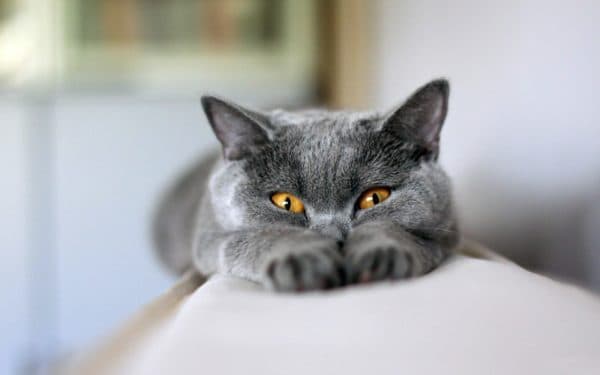
Breed predisposition. Some breeds are more susceptible than others to pathologies of the musculoskeletal system, muscle weakness, dysplasia and other diseases. The risk group includes the following cat breeds:
- Maine Coon, Chartreuse – hip dysplasia;
- kimrik – congenital weakness of the muscles of the limbs;
- Scottish Folds – osteochondrodysplasia.
Gender dependence. Cats suffer from immunosuppressive mono- and polyarthritis, which causes lameness and impaired limb mobility.
In males, pathologies of the hind limb girdle, joints and bones are 2 times more likely.
Other reasons. Impaired mobility of the hind limbs can be caused by a large number of pathogenic factors. Power supply errors can cause problems. For example, a lack of thiamine and vitamin D in the diet can lead to dragging of the hind legs, so without professional consultation and diagnostics it is impossible to determine an accurate diagnosis and prescribe treatment.
How to help if your cat is walking in circles
In this case, it is more important than ever to correctly and timely determine the cause of the problem and make the correct diagnosis. Self-medication is unacceptable here. As mentioned above, such symptoms are only rarely evidence of non-serious diseases, such as helminthiasis. In all other cases, if a cat walks in a circle, the pet’s health is in danger, which means that it needs to be taken to a veterinary clinic as soon as possible or a veterinarian can be called to your home. Such symptoms should not be ignored under any circumstances.
It is necessary to describe the cat's condition in detail to the veterinarian, as well as describe the animal's lifestyle, diet, possible injuries or other reasons that could lead to behavioral disorders.
It is especially worth paying attention to such problems as previous otitis media, physical injuries, blows, bruises, falls from great heights and other situations in which the cat could have been injured.
Then, based on the results of the examination, a diagnosis is made and treatment and medication are prescribed for the cat. For tests, you may need to give urine and blood (detailed biochemistry and OKA), do an ultrasound examination, or an MRI. Sometimes the animal is given a drip or given injections. During this period, the cat’s appetite may be severely impaired, it may refuse to eat, so its body must be helped to remain in a viable state, for this purpose the administration of saline solutions is prescribed.
How old is your pet? Ten? More? Then this is definitely the place for you! Because after 8-10 years, various age-related changes begin to occur in the cat’s body, which you need to be aware of and take into account. May your four-legged pet live happily ever after!
By the way, previously the age limit for our pets was much lower - 12-year-old cats were considered long-livers. It was man who raised the quality of life, and with it its duration, by one and a half to two times.
And now it is easy to meet cats that have reached 16-19 years of age, or even more. For example, in our clinic we see two cats, each 21 years old, and the most significant thing that worries them is their teeth, or rather, tartar, which is removed from them from time to time.
Well, the age of cats from the Guinness Book of Records generally exceeds the 30-year mark.
So, among pets, the number of “elderly” pets (approximately 30%) who need optimal care is increasing.
It is a fact that with the increase in the number of years lived, everything changes (and not only for cats :-)). Age-related changes affect all body functions. For now, we will consider only behavioral ones.
The causes of behavioral changes can be a number of diseases (including systemic ones) acquired by the animal over the years of its life, brain pathologies, as well as CDS - cognitive dysfunction syndrome. First, let's look at medical ailments, and then move on to the most interesting part.
Osteoarthritis
(joint disease) can be observed in 65% of cats over 12 years of age (the elbow and hip joints are most often affected, less often the knee and shoulder). Joint pain leads to decreased mobility and the appearance of aggressiveness when communicating with people and other animals.
Systemic hypertension
(high blood pressure) often causes the pet to scream at night, become disoriented in space, lose consciousness, senseless circular movements and even seizures.
Chronic kidney disease
most strongly influences behavior change: polyuria (increased volume of urine) entails urination in the wrong places, and with a lack of water, dehydration of brain tissue. Polydipsia (increased thirst) causes cats to drink from containers that are not intended for this purpose. The development of acidosis (increased body acidity) causes weight loss and drowsiness. And severe uremia (self-poisoning of the body with nitrogenous waste from urine) leads to uremic encephalopathy, a non-inflammatory disease of the brain. In addition, kidney disease is often accompanied by hypertension (see above).
Hyperthyroidism
(increased thyroid hormones) leads to the same consequences as chronic renal failure. In addition, it affects the concentration of thyroxine in the brain (manifests as anxiety and aggressiveness), causes polyphagia - the cat’s taste and appetite change.
Diabetes
has the same consequences as chronic renal failure and hyperthyroidism. In addition, it can cause sensory or motor neuropathies (irritability, increased sensitivity to external influences (touch), muscle pain).
Urinary tract infections
cause the animal pain and discomfort in the bladder or kidneys. The result is “incorrect” urination, anxiety, aggression, and depression.
Changes in appetite, weight loss, gastrointestinal diseases
, appearing due to physiological changes and pathological processes, are associated with a deterioration in the sense of smell and taste, pain in the oral cavity, for example, due to periodontal disease.
Hearing and vision loss
Cats quickly adapt to blindness. With deafness the situation is worse. Cats with poor hearing begin to make loud noises (possibly at night) because they have difficulty hearing their voices.
Brain tumors
more common in older cats (11 years and above). Meningioma, lymphoma, glioma, pituitary tumors are expressed by restlessness, circular movements and convulsions.
Pain
, especially constant, greatly exhausts the animal. Chronic pain most often occurs with artiritis, as well as with inflammatory processes in other organs, for example, with periodontal disease and diseases of the digestive tract (obstruction). Cats, due to their evolutionary development, are able to cope even with severe pain.
Infectious diseases
(viral immunodeficiency, viral leukemia, infectious peritonitis, toxoplasmosis) are the cause of neurological disorders and, consequently, behavioral changes.
So, there are many medical reasons for behavioral problems in older cats. And identifying them often requires a number of diagnostic studies. But if diseases are excluded, that is, when there is no obvious cause, then the animal’s behavior is considered to change under the influence of cognitive dysfunction syndrome
(SKD)
Alzheimer's? In cats?!
Yeah, something like that. Everything is like the big ones.
In cats with cognitive dysfunction syndrome, changes occur in the brain that lead to decreased mental abilities. This affects the processes of thinking, memory, learning new things, and using acquired skills.
Cognitive dysfunction syndrome
is a progressive disease with increasing signs of senile behavior
A third of 11-14 year old cats have at least one of the behavioral disorders caused by CDS, and in 15 year old cats the number of such problems is no less than 50%.
The most striking symptom of cognitive dysfunction is disorientation. The cat seems to get lost in the apartment, hides in a corner or under furniture, bumps into door frames in an attempt to find the door, does not recognize the owners or other animals, and does not respond to calls.
The sleep-wake pattern is often disrupted (as a rule, the cat sleeps more during the day and much less at night).
The proportion of purposeful actions decreases and the frequency of aimless wandering increases. There may be movements in a circle or involuntary oscillatory movements - tremor, or, conversely, immobility, weakness.
An older cat may go potty less often and go to inappropriate places more often.
The quality of communication with the owners deteriorates, the animal asks for less and less affection and attention.
Hind paw failure: the most common causes
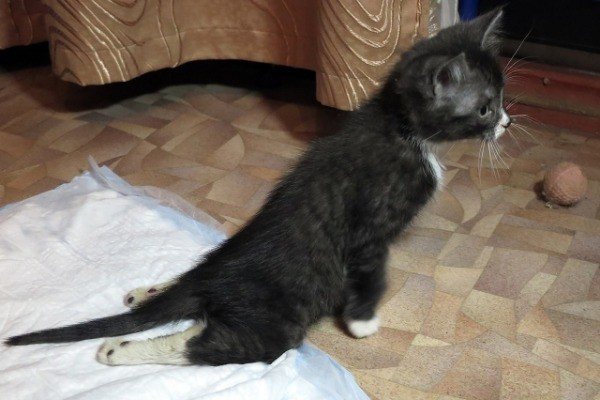
Loss of limb mobility can occur for a variety of reasons. It is extremely difficult for an animal owner to make a diagnosis on his own; a trip to a veterinary clinic will help to adequately assess the condition of a sick cat, completely cure and restore the pet.
- Spinal column injuries.
The hind limbs lose mobility due to spinal injuries. Particular attention should be paid to the lumbar region. A cat walking on the streets can get injured.
The spine can be damaged when hit by a car, bicycle, motorcycle, or falling from a tree or fence. Cats living at home can also injure their spinal column by falling from a ledge or cabinet. Symptoms: the pet drags its back, the tail is motionless, the cat feels weak.
- Thrombus in the femoral artery.
When the femoral artery is blocked (thromboembolism), the pet gradually loses sensitivity in the limbs, the cat suffers from severe pain in the lumbar region, screams, and tries to bite the lower back. Tissue necrosis that accompanies the blockage process leads to complete failure of the hind legs.
Where does SKD come from?
Possible reasons:
- disturbance of cerebral blood supply - a change in the circulatory system of the brain due to hypoxia caused by heart disease, hypertension, anemia, impaired blood clotting, the formation of small hemorrhages near blood vessels, arteriosclerosis
- tissue damage from free radicals As cells age, they process nutrients less and less well, the amount of energy decreases, and the number of free radicals in the cells increases, which the body’s antioxidant defense does not have time to neutralize. An excess of these radicals leads to tissue damage, with brain tissue being especially sensitive.
General recommendations

In addition to therapeutic measures, massage of the cat’s lumbar region and hind legs is included.
- Massage of the limbs and lumbar region is indicated in order to prevent atrophy of the muscle tissue of the hind legs. Should be done every day for about ten minutes.
- Some kind of gymnastic exercises will be a good help.
- You need to imitate the walking or running movements of the animal’s limbs. It is possible to imitate primitive walkers, when the fabric supports the cat under the stomach, and the paws move quietly along the floor.
- Swimming worked well. The pet strains its paws, involuntarily moves them in the water, while the owner supports it under its belly. You can also use a small ball. Place the cat on top and roll it back and forth so that its limbs touch the floor.
ACS diagnostics
To accurately determine the cause of a change in behavior in a cat, a complete examination is necessary. Unfortunately, both diagnosis and treatment of behavioral problems are often complicated by the presence of various diseases in the animal. And sometimes a combination of pathologies makes behavioral disorders especially severe.
On the other hand, sometimes behavioral symptoms that are actually caused by a serious illness are attributed to cognitive dysfunction syndrome.
The owner’s task is to identify “abnormalities” in the pet’s behavior and promptly report them to the doctor. In addition to changing behavior, it is important to monitor the amount of food and water consumed, weight loss, frequency of bowel movements and urination, etc.
And, of course, older animals need to regularly (1-2 times a year, more often with significant deviations) visit the veterinary clinic for a comprehensive examination (measurement of body weight, blood pressure, determination of the condition of the retina, concentration of thyroid hormones, physical activity, orthopedic and neurological examination, ultrasound diagnostics, tests and blood tests (general and biochemical), urine, etc.).
Dear owners! Timely detection of the disease and its correct treatment mean extended years of life for your pet.
What additional steps can be taken?
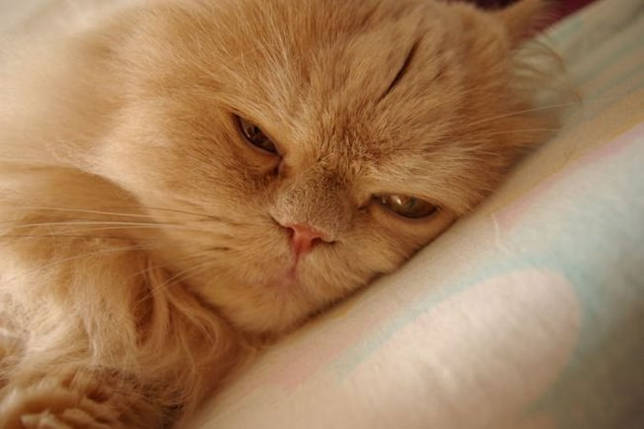
Once a competent veterinarian has been found and the necessary instructions have been received, the owner can speed up the treatment process by taking additional measures. Massage will help improve your cat's condition. It should be performed with light but fairly intense movements. This way the muscles will not have time to quickly atrophy. The massage must be performed every day for five sessions lasting ten minutes.
Do not give up water procedures. Even if the cat shows dissatisfaction. Swimming is very effective in the recovery process. It is enough just to lower the animal into the water a couple of times a week, where he would strain, trying to move them. At the same time, the cat needs to be supported.
Also, the basic treatment of paralyzed legs can be supplemented with ball exercises. Place on a ball of appropriate size. In this case, the paws should touch the floor. Your task is to make the cat begin to rest its limbs on the floor. To do this, slowly roll the ball back and forth.
Over time, when the paralysis of the hind legs subsides and sensitivity returns to them, try tickling the cat behind the ear. The reflex will work and he will attempt to reach the ear with his hind paw to scratch it. This will also be a kind of training.
Treatment of SCD
Treatment depends on the disease, this is understandable. What to do with “feline Alzheimer”?
Alas, while dogs diagnosed with SCD have been treated with medication (L-deprenyl is a drug used for people with Parkinson's disease), and then only in the USA and Canada, there are no approved medications for cats (some human remedies sometimes give positive results, but everything is still at the experimental stage).
Changing your diet may help. Ideally, food for older cats should contain antioxidants (a set of vitamins C, E and beta-carotene), essential fatty acids, as well as chondroprotectors (methionine, glucosamine, chondroitin) and the amino acids L-carnitine and lysine.
Someday!... In the meantime, we can offer our wards all possible treatment, comfort, peace, good food, and, most importantly, our love and care. Let our pets age gracefully!
Signs of limb failure
Symptoms to pay close attention to:
- Complete or partial impairment of motor function. The cat stops moving quickly, drags its limbs, and moves by crawling.
- Changes in gait. “Wobbling” of a small kitten is a normal phenomenon; a similar situation with an adult animal should alert the owner.
- Amyotrophy . Muscles lose elasticity.
- Pain on palpation of the hind limbs. The animal screams in pain if the back of its body is touched.
- Lack of sensitivity. The animal stops feeling heat and cold with its paws.
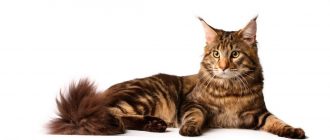
Be sure to read:
Rhinotracheitis in cats: symptoms and treatment, causes, how it is transmitted, best remedies, vaccination
Treatment on an outpatient basis and at home
The entire treatment regimen for ataxia, if possible and relevant, always directly depends on the root cause of the disease. Therefore, the list of prescriptions and dosages of drugs are never the same, even for the same form. And in this section we will provide only generally accepted medical recommendations in practice:
- Vitamin complexes following the example of Gamavit and especially B vitamins are always required;
- antibiotics will be needed if the cat is fighting an infection;
- diuretics - Furosemide, Veroshpiron - will help in the outflow of excess fluid during cerebral edema;
- in case of damage to the spinal cord (sensitive ataxia) - surgical intervention;
- for intoxication - droppers of saline solutions and glucocorticosteroids;
- severe muscle tremors can be treated with caution with Diazepam;
- Cerebrolysate - to improve cerebral circulation;
- Physiotherapy - UMI, UHF, massage;
- Piracetam, Cavinton and Glycine - to restore cerebral functions.
Important!
Please remember that any information on the Internet is for informational purposes only. Never prescribe medications to your cat without first examining and consulting a veterinarian.
Types of ataxia
Ataxia is divided into several types, depending on the affected area:
- Sensitive . Affects the cat's ability to bend and straighten its joints. Chances of cure only with the earliest possible diagnosis;
- Cerebellar . It can be static (loss of balance) or dynamic (impaired movement). It starts with small manifestations of awkwardness and maintaining balance. In the case of a genetic factor, it is incurable; in the case of a traumatic cause, the chances of recovery are real;
- Vestibular . It starts with all movements becoming slow and very careful. At later stages, the body tilt changes to the left or right, and the animal stops moving straight.
Diagnosis of a vestibular disorder in a cat
Only a physiological examination and study of the animal’s medical history can help in diagnosing disorders of the vestibular apparatus. Along with examining the cat's inner ear, it is also necessary to conduct a full range of neurological examinations. A blood test will assess the overall health of your pet. Perhaps it will help find out the cause of the vestibular disorder. It is recommended to conduct a complete blood test, including biochemical and sugar content. It would be nice to have the results of a urine test (general and Nechiporenko) to determine the normal functioning of the liver and kidneys, to rule out the toxic nature of the disorder. If the disease cannot be diagnosed even after these tests, then a spinal tap, MRI, or x-ray of the skull may be required. If the results of these tests are negative, then central vestibular disorder can be safely excluded from the list of possible causes of the disease, despite the similarity in the manifestation of symptoms. There are quite a few options for brain damage (tumors, cysts, infiltrates, etc.) from which you can start and establish the truth of these neurological disorders.
However, since we are talking about vestibular syndrome, it is very important to determine what type of vestibular disorder your pet suffers from. And all this is definitely a prerequisite for a pet treatment program.
Help save the cat! The cat is dying.
Really need some good advice! After suffering from an illness, the cat was vaccinated some time later. After vaccination (on the 3rd day), the cat seemed to have lost his limbs (I can’t call him paralysis, because he still moves them). Side effects on the central nervous system. Stretching of the limbs as if in convulsions (the convulsions themselves are not observed, as the skier stretches out his paws and slides on the linoleum), twitching of the head while lapping up liquid, as if hiccups (but this is definitely not hiccups). The cat has been eating almost nothing for about 3 days (I feed him broth from a spoon), and goes to the toilet once every 1-2 days, “in a small way.” He doesn’t walk or sit on his own, he just lies on his side. He also has difficulty holding his head. The gaze is conscious, purrs. The doctor cannot do anything, the diagnosis is also unclear. Only the words: “I can’t say anything, all I can do is give injections and hope.” I have already stopped calling the doctor (the doctor is one of the best in the city, only good reviews). I don't want to put you to sleep. I believe that if there is even a small chance, it should be used. Help, what else can be done? Below is our entire medical history for professionals: I’ll start from the beginning: we adopted a small kitten (1-1.5 months) at an animal shelter (June 2012). The kitten turned out to be sick. A week later I lost a lot of weight, I was treated for an intestinal infection (the antiviral drug fosprenil, the immunostimulant catasal and the antibiotic I don’t remember the name of). He was cured within a week. October 2012 - the cat refused food. The reasons are unknown, we didn’t keep track, because... at that time the child was in the hospital. During the child’s injury, the cat really experienced stress, hid under the sofa and sat there for half a day. We contacted the veterinarian. The cause of the disease was never found out; a blood test was taken - everything was within the physiological norm. Treatment for about 3 weeks: fosprenil (antiviral), cobactan (antibiotic), catazal (immunostimulant). It seems that the cat has more or less come to his senses. We finished the treatment. A week later, the cat’s eyes “closed” (that is, the inner eyelid closed the eye by approximately 1/3). Back to the doctor. They said: feline herpes. We resumed fosprenil + anandin drops in the eyes and nose. We treated for 2 weeks. The cat did not feel better. Here at the clinic the head doctor (the owner of the clinic) took care of us. The cat has a temperature of 41.2 (normal 38-39). He prescribed an antibiotic (human suspension amoxiclav). Weekly blood monitoring (the blood, by the way, was normal). The cat is on the mend. The cat began to eat, play, in a word, returned to normal life. Treatment was completed on the 20th of December. After 10 days we were given an anthelmintic, and after another 10 days we were given the Multifel-4 vaccination. 2 days after vaccination, the cat seemed to be paralyzed. It felt like he was having a stroke. His legs were in convulsions, at first he walked on high, straight legs (like on stilts). I couldn’t keep my balance, I fell on my side, I could crash into a door frame, I refused to eat or use the toilet. Back to the doctor. Treatment: saline dropper + piracetam + vitamins B1, B6 alternately, + cerebrolysate (all drugs from a human pharmacy). On the 2nd day of treatment, hope was lost, but the treatment was not abandoned. On the 5th day the cat came to his senses. His joy knew no bounds. On the 7th day of illness, the cat again (out of nowhere, one might say) became ill. I pet him, give him a massage, stretch his paws, warm him up, give him injections and IVs. By the way, I have never had a more sincere and intelligent animal in my life. Can you imagine a cat playing hide and seek with a child! Despite all his illnesses, there was never any thought of abandoning him. You never expect a trick from him, he will never do dirty tricks or steal something from the sly. Every morning I wake up and every day I return from work and there is no confidence that he will wait for me...
Prevention
- Mandatory vaccination against panleukopenia, rhinovirus and feline leukemia virus.
- To avoid injury to the animal as much as possible, it is advisable to limit free access to the street.
- Careful protection of the health of a pregnant cat, a ban on its communication with other animals.
- When planning a mating, be sure to check the cat for panleukopenia.
- Timely treatment of otitis and inflammatory ear diseases.
- Urgent hospitalization of a cat if a traumatic brain injury is suspected.
- Check with the breeder about genetic diseases in relatives and about the mother’s pregnancy history.
